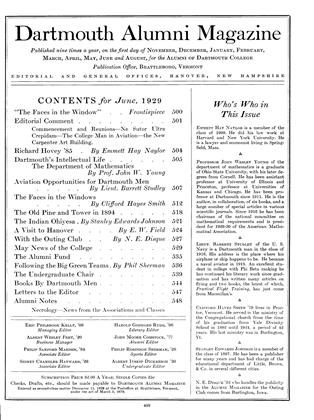It has occurred to me that few people know how the famous Stein Song came to be written.
In 1896 when the Psi Upsilon Fraternity were to hold their convention at Ann Arbor. Michigan, the late Andrew D. White, Ambassador to Germany, and then President of Cornell University, cabled to Richard Hovey, who was then visiting Maurice Maeterlinck in Belgium, to come to Ann Arbor and be prepared to read an ode written for the occasion.
When Hovey received the cablegram he was, as usual, "broke," so he took passage on a cattleship and started for the United States. Amidst these bucolic surroundings at sea he wrote his wonderful "Ode to Youth In the Springtime" but when it was done he felt that it needed to be lightened up a little by having a refrain so he wrote this refrain which are the words of the present "Stein Song."
One morning a few weeks later Arthur Livermore in going to his law office in Wall Street found Hovey parked outside his door. Mr. Livermore took the poet to his home.
He read to Mr. Livermore his ode and Mr. Livermore was very much impressed with it and said at the time that he thought the refrain was excellent in itself.
Hovey arrived at Ann Arbor and had a glorious time and read his ode which made a very deep impression, not only on those who heard him, but those who afterwards read it. It was widely published and later by arrangement with Bullard the refrain in this ode was set to music and is now known as "The Stein Song."
It was my honor in 1926, as National Secretary of Psi Upsilon, to be asked to read the same ode on the same place in the old Baptist Church in Ann Arbor where Richard Hovey had first read it in 1896.
 View Full Issue
View Full Issue
More From This Issue
-
 Article
ArticleThe Faces in the Windows
June 1929 By Clifford Hayes Smith '79 -
 Article
ArticleAviation Opportunities for Dartmouth Men
June 1929 By Lieut.Barrett Studley,U.S.Navy -
 Class Notes
Class NotesCLASS of 1923
June 1929 By Truman T.Metzel -
 Lettter from the Editor
Lettter from the EditorEditorial Comment
June 1929 -
 Article
ArticleA Visit to Hanover
June 1929 By E.W.Field -
 Class Notes
Class NotesCLASS of 1898
June 1929 By H.Philip Patey
Emmett Hay Naylor '09
Article
-
 Article
ArticleMasthead
JANUARY, 1928 -
 Article
ArticleNew Dartmouth Editor
JANUARY 1929 -
 Article
ArticleThird Century Fund Reaches Final Total of $53 Million
MAY 1971 -
 Article
ArticleAll The Green's a Stage
JANUARY 1999 -
 Article
ArticleTuck School
JUNE 1968 By 808 KIMBALL T'48 -
 Article
ArticleThe Undergraduate Chair
NOVEMBER 1965 By LARRY GEIGER '66


